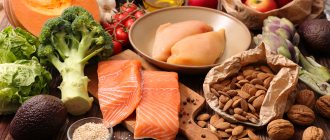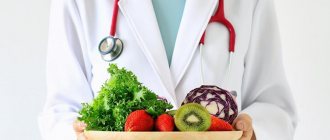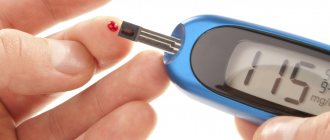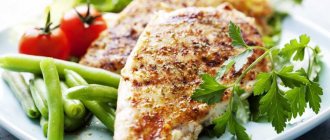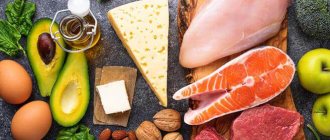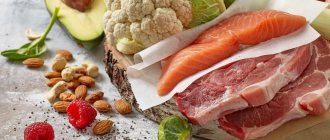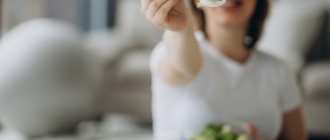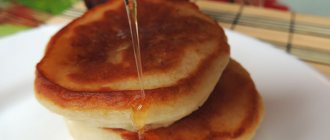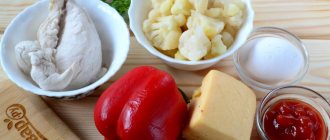Fruits and vegetables for diabetics
They are divided into 3 groups:
1 group. The nutritional value of the products is up to 5 grams of carbohydrates per 100 grams of product. The following products fall under this category:
- cucumbers,
- tomatoes,
- cauliflower,
- zucchini,
- eggplants,
- salad,
- radish,
- mushrooms,
- sorrel,
- spinach,
- rhubarb,
- cranberry,
- lemon,
- pumpkin,
- apples,
- sea buckthorn,
- sour plum.
It is allowed to consume up to 600–800 grams of these products per day.
Always have some approved products on hand. If you do not have time to eat at the prescribed time or feel hungry, it is better to eat a prepared product than fast food
2nd group. The nutritional value of products ranges from 5 to 10 grams of carbohydrates per 100 grams of product. The following products fall under this category:
Low carbohydrate diet for type 2 diabetes
- carrot,
- beet,
- onion,
- swede,
- celery,
- Bell pepper,
- beans,
- tangerines,
- oranges,
- grapefruit,
- apricots,
- cherry plum,
- watermelon;
- melon,
- pear,
- peaches,
- cowberry,
- strawberries,
- raspberries,
- currant,
- blueberry,
- sweet plum.
You are allowed to consume up to 200 grams of these products per day.
Eliminate carbonated drinks from your diet. It would be best to prepare your own drink from fresh vegetables, for example, carrots, tomatoes and cucumbers
3rd group. The nutritional value of the products is more than 10 g of carbohydrates per 100 g of product. The following products fall under this category:
- potato,
- green peas),
- potatoes (sweet),
- pineapples,
- bananas,
- pomegranate,
- figs,
- cherry,
- dates,
- persimmon,
- cherries,
- grape,
- raisin,
- dried apricots,
- prunes.
For diabetics with type 2 diabetes, consumption of the above products is not recommended. You can include them in your diet if you really want to, but in limited quantities and after the approval of your doctor.
Reducing the dosage of insulin and diabetes pills
If you are on a low-carb diet, use short-acting insulin injections before meals. The time of action of such insulin correlates well with the time of conversion of proteins into glucose.
What foods should be included in the diet of a patient with prediabetes?
Literally from the first days a diabetic begins to eat according to the rules of a low-carbohydrate diet, his blood sugar decreases. This effect is especially noticeable after eating. If you do not adjust the dose of injected insulin or the number of sugar-lowering tablets, it is easy to fall into hypoglycemia.
The transition to a diet should be gradual. The doses/volume of drugs administered/taken should be adjusted daily to the actual measured sugar concentrations. Naturally, they will decrease.
How to make a menu correctly
When suffering from diabetes, patients are advised to adhere to the nutritional principles of “table No. 9” according to Pevzner. At first glance, it seems that the diet is strict, but it is not. Diet therapy according to table No. 9 is, first of all, a reduction in the carbohydrate component in the daily diet, while food containing protein remains normal. Meals should be provided daily in small portions. Due to excess weight in diabetics, it is recommended to eat low-calorie foods. When reducing calories, consume no more than 2300 kcal per day.
Eating in equal portions and at certain times is the path to success in treating diabetes.
You should limit your consumption of alcoholic beverages, salt and spicy foods for a number of reasons:
- Salt. It retains excess fluid in the body, which creates additional pressure on the kidneys, which are already susceptible to developing complications.
- Alcoholic drinks. Firstly, the stronger the alcohol, the more calories it contains. Secondly, alcohol-containing drinks quickly raise the level of glucose concentration in the blood vessels.
- Spicy food. Limitation of consumption is recommended due to increased appetite.
The ideal meal is considered fractional: 5-6 times a day with equal shares of proteins, fats and carbohydrates. The last meal should not be less than 2 hours before bedtime. It is recommended to schedule food consumption by day and hour. This rule is explained by the fact that the body will work for hours every day and will enter a normal rhythm.
How to adjust the menu based on the results of the first days
If you switch to a low-carb diet if you have diabetes, you will first have to make daily adjustments to your diet for a while. The chosen amount of food may not be enough and you will experience discomfort. Increase the portion and be sure to recalculate the dose of insulin administered.
Keeping records for several days will help you choose the right diet plan. Your goal is to ensure that the dependence of changes in sugar levels on food intake does not exceed 0.6 mmol/l.
A constant amount of protein and carbohydrates eaten with a single serving of food guarantees a stable blood sugar level. When calculating the dose of insulin, be sure to take into account the amount of protein in the product offered for consumption.
Diet for type 2 diabetes for a week
Every person wants varied and tasty food. A diabetic needs to approach this with all responsibility and intelligence so that the food is balanced and, of course, tasty.
Be creative when preparing your diet for the week, and the fight against diabetes will not be a burden for you
An example of a weekly menu (a list of dishes that you can choose is provided):
Monday
- Breakfast: oatmeal with skim milk, bran bread, tomato juice.
- Snack: milk jelly (use a sweetener for preparation), fresh or baked apples.
- Lunch: chicken soup with millet, pea soup, cucumber and tomato salad, black bread, chicken breast, green tea.
- Afternoon snack: green apple, prunes or light salad.
- Dinner: fresh white cabbage salad, buckwheat porridge with mushrooms, bran bread, boiled egg or omelet, mineral (still) water.
- Snack 2 hours before bedtime: fermented baked milk, kefir or unsweetened low-fat yogurt.
Daily diet from Elena Malysheva
Elena Malysheva has been broadcasting about health for a long time and knows everything about the diet for type 2 diabetes. A diabetic should have breakfast before 8 am. It is better to start the day with oatmeal, and not with milk, but steamed with boiling water. You can use kefir or low-fat cottage cheese with porridge. 2 hours after breakfast, it is recommended to have a snack of boiled vegetables or unsweetened fruits. You should start having lunch no later than 12 noon. The menu includes boiled fish or meat and a salad of fresh vegetables without spicy seasonings and with a minimum amount of salt.
If desired, you can add 1-2 tablespoons of olive oil to fish or meat. The afternoon snack should be light, consisting of a glass of milk or kefir without sugar or sweeteners. Dinner must take place no later than 19:00. It is best not to load your stomach with heavy meals and eat some vegetables or fruits.
By following dietary instructions and advice, a diabetic will be able to return to normal life in a short time, while preventing the development of complications from diabetes.
Low Carb Diet Recipes for Diabetics
Along with physical activity, a diet that limits carbohydrate intake is definitely recommended for patients with diabetes. Using a low-carbohydrate diet, a patient with non-insulin-dependent diabetes can completely get rid of the disease, and a patient with T1DM can live for a long time, compensating for their diabetes with significantly lower doses of insulin.
After reviewing the list of recommended foods for diabetes, anyone can create an acceptable menu for themselves. Through food we must consume proteins, fats and carbohydrates in order to live. It is important to determine the ratio of these products in our diet.
Proteins are the basis of a low-carb diet. Proteins can also be converted into glucose, but this process occurs slowly and does not cause sharp fluctuations in blood sugar. Eat without fear:
- Fish;
- Bird;
- Animal meat;
- Eggs.
Among dairy products, preference is given to:
- Fermented milk products;
- Cheese;
- Butter;
- Cream;
- Cottage cheese (with restrictions).
Every day you can eat 250 - 400 grams of foods containing protein (but not containing carbohydrates). Plant sources of protein (beans, soy and others) contain carbohydrates and should be consumed sparingly.
If you consume animal products, you protect your body from carbohydrates. These foods contain protein (~20%), fat and water.
Animal fats can and should be eaten. They are a source of energy and building material for cells. Excess fat is stored in reserve. High-quality fatty foods are recommended on a low-carb diet.
Eaten fats replenish the fat layer if they are consumed together with carbohydrates (for example, a piece of cake). If you follow a low-carb diet, all the fat you eat is instantly converted into energy.
It is impossible to overeat on fats and proteins; the body will immediately react negatively - belching, heartburn, diarrhea. We can absorb carbohydrates unlimitedly.
Carbohydrates are a source of energy. You don’t have to give them up completely, but you need to make the right choice. Strictly prohibited:
- Sugar;
- Sucrose;
- Maltose;
- Lactose;
- Syrup.
Products of plant origin contain a combination of carbohydrates - starch, sugar, dietary fiber. Only starch and sugar cause a sugar spike. The recommended carbohydrate intake per day for diabetics is 20 grams. For your diet, you need to choose foods with a GI <55.
Almost all vegetables are allowed (potatoes are excluded; carrots and beets are subject to restrictions).
Porridge - exclude white rice and semolina.
Each person has their own permissible intake of carbohydrates. To determine it, measure your sugar level before meals and 2 hours after. Start with 6 grams of carbohydrates per meal. Gradually increase the amount of carbohydrates you eat until your sugar remains below 8 mmol/L. You are allowed to eat up to 90 grams of carbohydrates per day, as long as sugar remains within acceptable limits.
To keep sugar under control, it is recommended to follow the following dietary rules: Breakfast, lunch and dinner should contain the same amount of proteins and carbohydrates every day.
For variety, the set of products should change while maintaining the same ratio of proteins and carbohydrates in a serving of food. This diet will allow you to keep your sugar within normal limits and not change the dose of insulin/pills. Special tables will help you correctly calculate the amount of carbohydrates in a prepared dish.
During the day, carbohydrate intake should be distributed as follows:
- In the morning –20% (6 g);
- During the day – 40% (12g);
- In the evening – 40% (6-12 g).
Sugar substitute for diabetes
In the morning hours, the body “slows down” insulin production. In the morning, it is recommended to have a hearty protein breakfast. A long-lasting feeling of fullness will protect you from snacking and your hand will not reach for harmful fast food.
It is better to take lunch with you from home in a container. It is unlikely that you will be able to find food without carbohydrates in public catering.
You should have dinner no later than 18/19 hours. The protein food will have time to digest, and in the morning you will have breakfast with appetite.
If you suffer from gastroparesis, reduce the amount of food you eat in the evening. Replace raw vegetables with boiled ones.
A recipe everyone will love, Chicken Salad has only 9.4 grams of carbs.
We will need:
- Chicken breast (200 g):
- Beijing cabbage (200 g);
- Cherry tomatoes (150 g)
- 1 onion;
- Soy sauce, olive oil, lemon juice.
The base is chopped Chinese cabbage. Place onion, cut into half rings, on top. Next comes a layer of slices of steamed breast. Finally, add a layer of thinly sliced tomatoes. For dressing, mix olive oil, soy sauce and lemon juice to taste.
Cabbage mix recipe
- Cabbage - cauliflower, broccoli, Brussels sprouts (400 g each).
- Cheese.
- Sour cream.
Boil the cabbage, drain, simmer in a frying pan with sour cream. Sprinkle with grated cheese.
Recipe for those with a sweet tooth – green ice cream
- Avocado – 2 pcs.
- Orange - zest.
- Cocoa powder – 4 tbsp. spoons.
- Stevia (syrup) – a few drops.
In a blender, combine avocado (pulp), zest, cocoa and stevia. Pour the mixture into a mold and put it in the freezer.
Switching to a low-carbohydrate diet implies a complete abstinence from fruits; berries are allowed. Products for diabetics containing fructose reduce tissue sensitivity to insulin.
Low-fat or 0% fat foods contain more carbohydrates than “normal fat” foods.
Gourmet menu:
- Breakfast (10 g carbohydrates) – scrambled eggs with spinach, a cup of blackberries, coffee with cream.
- Lunch (12 g carbohydrates) – salad (chicken + Roquefort cheese + bacon + avocado + tomato + oil (olive) + vinegar), dark chocolate, tea.
- Dinner (11 g carbohydrates) – grilled salmon, zucchini (fried), mushrooms (fried), strawberries and cream, walnuts, glass of red wine.
Diet recipes
Cottage cheese casserole without semolina and flour
To prepare, you will need 250 g of cottage cheese (the cottage cheese should not be low-fat), 70 ml of milk, a couple of eggs, lemon peel, vanilla.
Method of preparation: grate the lemon peel on a fine grater, add egg yolks, cottage cheese, milk, vanilla and mix by hand with a fork or using a blender. The whites need to be cooled, beat them in a bowl until foamy, and add a little salt. Pour the egg whites into the curd mass, then pour the mixture into a mold that has been greased in advance. Bake for 30 minutes at 160 degrees.
Chicken soup with pumpkin and mint
To prepare, you will need half a kilo of pumpkin, 150 g of chicken fillet, which is the daily norm for a diabetic, 1 small onion, 50 g of cheese.
Method of preparation: peel the pumpkin and cut into small cubes. Boil the chicken fillet for 25 minutes, drain the broth at least 2 times. Cut the onion into rings. Sauté the onion and pumpkin in a frying pan. Grind the boiled fillet and mix with the stewed pumpkin, then grind it all using a blender. After the consistency has become homogeneous, pour it into the broth (since the broth is not very fatty, it can be consumed even if you have diabetes). Stir until you get a puree. Before serving dinner, add chopped cheese and mint leaves to the plate.
Adding sugar to dessert is undesirable, but is allowed in small quantities. One of the best desserts will be baked apples with cottage cheese; this is a completely dietary product.
It is important that a diabetic does not experience any dietary restrictions. Try to cook different dishes every week, or better yet, keep a food diary, and the feeling that you are fighting an illness will never visit you.
Your health depends entirely on your lifestyle and needs support. Watch your diet, eat healthy and tasty. Your doctor or nutritionist will help with this. Be healthy!
